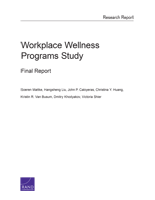| 来源类型 | Report
|
| 规范类型 | 报告
|
| DOI | https://doi.org/10.7249/RR254
|
| 来源ID | RR-254-DOL
|
| Workplace Wellness Programs Study: Final Report |
| Soeren Mattke; Harry H. Liu; John P. Caloyeras; Christina Y. Huang; Kristin R. Van Busum; Dmitry Khodyakov; Victoria Shier
|
| 发表日期 | 2013-05-30
|
| 出版年 | 2013
|
| 语种 | 英语
|
| 结论 | Characteristics and Prevalence - Approximately half of U.S. employers offer wellness promotion initiatives, and larger employers are more likely to have more complex programs.
- Programs often include wellness screening activities to identify health risks and interventions to reduce risks and promote healthy lifestyles.
Impact- Employee uptake of worksite wellness programs remains limited. Fewer than half of employees (46 percent) in the firms surveyed undergo clinical screening or complete a health risk assessment (HRA), which is used to identify employees for interventions.
- We found statistically significant and clinically meaningful improvements among program participants in exercise frequency, smoking behavior, and weight control, but not cholesterol control.
- Participation in a wellness program over five years is associated with lower health care costs and decreasing health care use. The average annual difference is an estimated $157, but the change is not statistically significant.
The Role of Financial Incentives- Incentives for completing an HRA are effective, particularly above a threshold of $50. On average, an increase in the HRA incentive by $10 is associated with a 1.6 percentage point increase in the HRA completion rate for incentives in the range of $0-$100.
- Smoking cessation is also the only health behavior for which achieving the goal earned a greater reward than participating in a program.
- "High-powered" incentives that tie as much as 20% of the cost of coverage to achieving a health goal remain rare.
Key Facilitators- Broad outreach and clear messaging from organizational leaders.
- Making wellness activities convenient and accessible for all employees.
- Making wellness an organizational priority among senior leaders.
- Leveraging existing resources and building relationships with health plans to expand offerings at little to no cost.
- Approaching wellness with a continuous quality improvement attitude, and solicit feedback from employees to improve programs.
|
| 摘要 | The report investigates the characteristics of workplace wellness programs, their prevalence, their impact on employee health and medical cost, facilitators of their success, and the role of incentives in such programs. The authors employ four data collection and analysis streams: a review of the scientific and trade literature, a national survey of employers, a longitudinal analysis of medical claims and wellness program data from a sample of employers, and five case studies of existing wellness programs in a diverse set of employers to gauge the effectiveness of wellness programs and employees' and employers' experiences. |
| 目录 |
Chapter One
Introduction
Chapter Two
Methods
Chapter Three
Employer-Based Wellness Program Characteristics and Prevalence
Chapter Four
Program Impact
Chapter Five
The Role of Incentives
Chapter Six
Lessons from Case Studies for Program Implementation
Chapter Seven
Conclusions
Appendix A
Employer Survey Sampling Methods
Appendix B
CCA Data Analysis Methods
|
| 主题 | Chronic Diseases and Conditions
; Health and Wellness Promotion
; Health Behaviors
; Health Care Costs
; Health Insurance
; Workforce Management
; Workplace Wellness Programs
|
| URL | https://www.rand.org/pubs/research_reports/RR254.html
|
| 来源智库 | RAND Corporation (United States)
|
| 引用统计 |
|
| 资源类型 | 智库出版物
|
| 条目标识符 | http://119.78.100.153/handle/2XGU8XDN/522279
|
推荐引用方式
GB/T 7714 |
Soeren Mattke,Harry H. Liu,John P. Caloyeras,et al. Workplace Wellness Programs Study: Final Report. 2013.
|
|
文件名:
|
RAND_RR254.pdf
|
|
格式:
|
Adobe PDF
|
|
文件名:
|
1397824215374.gif
|
|
格式:
|
GIF
|

除非特别说明,本系统中所有内容都受版权保护,并保留所有权利。
